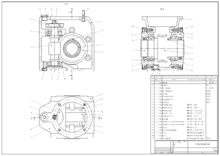
Back مكونات المادة Arabic Arxiu BOM Catalan Kusovník Czech Stückliste German فهرست مواد اولیه Persian Nomenclature (logistique) French Distinta base Italian BOM (部品表) Japanese 자재 명세서 Korean Stuklijst Dutch

A bill of materials or product structure (sometimes bill of material, BOM or associated list) is a list of the raw materials, sub-assemblies, intermediate assemblies, sub-components, parts, and the quantities of each needed to manufacture an end product. A BOM may be used for communication between manufacturing partners or confined to a single manufacturing plant. A bill of materials is often tied to a production order whose issuance may generate reservations for components in the bill of materials that are in stock and requisitions for components that are not in stock.
The first hierarchical databases were developed for automating bills of materials for manufacturing organizations in the early 1960s. At present, this BOM is used as a data base to identify the many parts and their codes in automobile manufacturing companies.
A BOM can also be visually represented by a product structure tree, although they are rarely used in the workplace.[1] For example, one of them is Time-Phased Product Structure[2] where this diagram illustrates the time needed to build or acquire the needed components to assemble the final product. For each product, the time-phased product structure shows the sequence and duration of each operation.
© MMXXIII Rich X Search. We shall prevail. All rights reserved. Rich X Search